If you’ve been batting for a while, it’s likely that by now you’ll have managed to nail all of the basics like how to grip the bat and how to position yourself at the crease. You may even have managed to learn how to score runs on a regular basis! However, as you get older and more experienced, you’ll probably end up batting against bowlers that are a lot faster and more skilful! It was at about this time in my career that some of my coaches started recommending that I think about adding a trigger movement to my technique – and back then I didn’t have a clue what a trigger move was, or why it would help me!
If you’re in a similar position now to the position I was in back then, then this is the post for you. After coaches began mentioning them to me I did a lot of research on trigger movements, and spent a lot of time trying to incorporate one into my batting technique. If this is something that you want to do, or even if you just want to see whether it is the right choice for you at this stage of your career, then I think I’ll be able to give you some good advice!
In this post, I’m going to take you through what a trigger movement is, what benefits they offer, what the disadvantages are, and we’ll also look at some examples that are used by world class batsmen. Hopefully once you’ve read through all of this you’ll be able to make a much more informed decision regarding your own batting technique!
What Is A Trigger Movement?
A trigger movement is a movement of the feet that takes place just before the ball is bowled. The movement should be easily repeatable, so that it can be used before each delivery. Trigger movements help batsmen to get themselves into a position from which they can easily play a front or back foot shot. They’re also used so that batsmen can carry a little momentum into their shots, rather than being completely still as the ball is bowled. Many batsmen find it easier to react to a fast ball if their feet are already in motion!
Some batsmen have large trigger movements that require them to move large distances across the crease. Steve Smith of Australia is probably the best example of this. Dominic Sibley, one of England’s opening batsmen is also a good example. Some batsmen are a lot more conventional and barely move their feet at all as the ball is delivered. Sachin Tendulkar is the first example that springs to mind when I think of this!
Do All Batsmen Need To Have A Trigger Movement?
The simple answer to this is no. As I just mentioned above, Sachin Tendulkar’s batting technique didn’t really feature a trigger movement, and he is one of the finest players ever to pick up a bat!
The decision of whether to begin working on a trigger movement is entirely your own. Coaches, your parents and your friends can have their opinions, but this is your batting technique – so it’s your choice! When making this decision, you’ll need to know the positives as well as the negatives of adding a trigger movement to your technique. I’ll take you through those in the next section!
Firstly though, if you’re a young batsman that is new to the game and you’re still only playing junior cricket, don’t feel like you’re missing out too much if you don’t have a trigger movement. In your first few years of batting (especially when you’re competing against junior bowlers), you should be focusing more on getting comfortable with your grip, your stance, and being able to hit the ball on a regular basis. I’m a firm believer that these foundational years should be spent on establishing the basics of your batting technique and building some confidence with the bat in your hand.
Once you have all of those things mastered, you can move on to think about the finer technical details of batting like trigger movements. Of course, there will be some junior batsmen who are quite advanced for their age, and these players may end up taking part in senior cricket against adults who are able to bowl a lot faster. If you’re one of these advanced junior players and you feel like a trigger move would enhance your ability to bat against faster bowlers, you can think about adding a trigger to your game. Just be aware you’re going to have to put in a lot of work to do so!
Players who have aspirations of playing cricket at elite levels such as in county/state teams or playing for their country will be more under pressure to use a trigger movement due to the calibre of bowling they will be facing on a regular basis. However, even in that instance, it will still come down to the preference of the batsman in question!
What Are The Advantages of a Trigger Movement?
If we’re going to make a change to our technique, we have to know exactly how it is going to benefit us. Having a good trigger movement will give you the following advantages:
- They Help You Get Your Feet Moving – a well-executed trigger movement will help you to get your feet moving just prior to the ball being bowled. This benefits a lot of players when they face fast bowlers because they believe it is easier to react to a ball if your feet are already active. Many batsmen don’t like keeping their feet completely still while the bowler is approaching and then springing into action once the ball leaves their hand.
- Allows You To Transfer Your Weight Effectively – Performing the trigger movement can help you to move your body into an effective position from which it is easy to play a shot. I like my weight to be slightly over my front leg after performing my trigger, so that I can easily continue going forwards if the ball is full, or push back into my crease if the ball is short.
- Can Help You To Get Into A Good Rhythm At The Crease – As many of you will know, batting is all about rhythm. Having good rhythm at the crease will allow you to time your shots much better, which will lead to you having more control over them. A well-executed and well timed trigger movement will help you make sure your body and your bat are coming towards the ball at the right moment.
What Are The Disadvantages of a Trigger Movement?
Like any technical adjustment in cricket, the addition of a trigger move does come with a few negatives! Let’s have a look at some of them:
- They Require A Lot Of Practice – The key with a trigger movement is to become so comfortable with it that you don’t have to think about it anymore. This is perfect as it allows you to focus completely on the ball that is being delivered and playing your shot. To get to the point where you don’t have to think about your trigger movement, you will have to spend many weeks and maybe even months practicing it!
- A Small Error In Timing Can Ruin Your Shot – If you mistime your trigger move ever so slightly, it can lead to you playing a mistimed shot. Mistimed shots can often lead to opportunities for the bowlers and the fielding side! If you go through your trigger move too late, you may not get your feet in place quickly enough for you to play your shot. Go through your trigger too early, and you may end up stationary for a small period and lose the momentum in your feet that the trigger move was intended to create.
- Certain Trigger Moves Can Get You In Bad Positions – At the end of your trigger move you should have gotten yourself into an athletic position which will allow you to react quickly to the ball. You should be nice and balanced, with your feet not too wide apart, and not too close together. Your head and eyes should also be level. Some trigger movements get batsmen into bad positions, and these should be avoided at all costs. More on this later in the post!
What Types Of Trigger Move Can You Use?
Now for the really interesting part of the post! In this section we’re going to look at different types of trigger movements that some of the top batsmen in the game use and evaluate them. This will help you to get to know what trigger movements look like, and it should give you some ideas of things you can do if you want to add one to your game. Let’s start with one of my favourite batsmen ever – Kevin Pietersen…
Kevin Pietersen’s Trigger Movement
Kevin Pietersen was a hugely destructive batsman and could destroy any bowling attack in any conditions in his prime. As a young lad just starting to play cricket when he entered the England team, I was fascinated by his technique and his aggressive style of batting. When examining his trigger movement, we’ll look at things from two angles. A front-on view, and a side-on view.
Front-On View
If you watch footage of Kevin batting you can see that he usually takes guard close to leg stump when facing fast bowlers. If you’re not sure what ‘taking guard’ means, I’d recommend clicking here to read a bit about it before you go any further! As he goes through his trigger move, this shifts Kevin’s body across the crease, over towards the off stump. This movement isn’t huge, but it is significant, as it allows KP to get his eyes over the line of off stump. Many batsmen think this will help them to know when they should be leaving the ball. I’ve included a few diagrams below which show KP’s trigger move from start to finish. These will help you see the shift in KP’s body position thanks to his trigger!
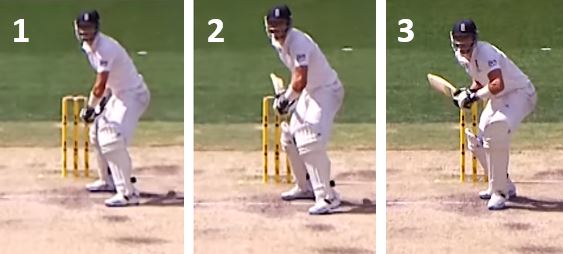
Side-On View
This angle is where you really can get a good idea of the types of movements KP is making, and I’ve included another step by step diagram below to help you visualise it. KP’s normal batting stance (which you can see in picture 1 below) is quite wide, and this isn’t really considered to be an optimal position to be in when playing the ball. It’s very hard to move forwards or backwards quickly from this position! KP’s trigger helps him shift from this wide base position into a much more compact, athletic position, with his weight nicely positioned over his front leg. You can see this compact position in picture 3 below!
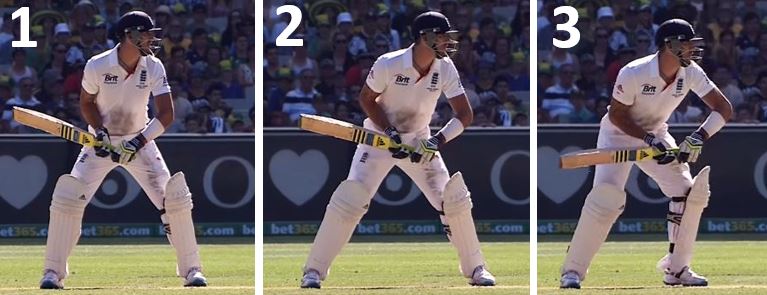
To go from picture 1 to picture 2, KP moves his back foot backwards slightly. The back foot also moves slightly across to the off stump rather than going straight backwards, as we looked at during the front-on section of the review! Now to go from picture 2 to picture 3, KP brings his front leg closer to his back leg, and underneath his eyes. This ensures that KP’s head is over his front knee, meaning that his weight is coming forwards towards the ball. I see this as a great position to get into! From here, KP can quickly come forward to a full ball, or push backwards off the front leg to play a back foot shot!
Steve Smith’s Trigger Movement
This will probably be the most extravagant trigger movement that I take you through in this post, and it’s definitely one of the most famous ones! As many of you will know, Steve Smith’s meteoric rise to batting greatness over the past few years has been accentuated by the little quirks in his technique, and his trigger move is probably the most famous one! So, what does it look like? Let’s examine it…
Front-On View
With Steve Smith, the most interesting angle to look at is the front-on view. I’ve included pictures 1-3 below to show how his trigger movement allows him to shift his position at the crease! In picture 1, you can see that Smith takes a leg stump guard. This is his basic batting stance. The first part of the trigger movement (which occurs around the time the bowler reaches the umpire) is to move his back foot across the crease towards the off stump. You can see this movement in photo number 2! Sometimes his back foot ends up on the line of off stump, and sometimes it goes slightly past it. My guess is that he goes as far across as necessary based on the type of bowler that he is facing!
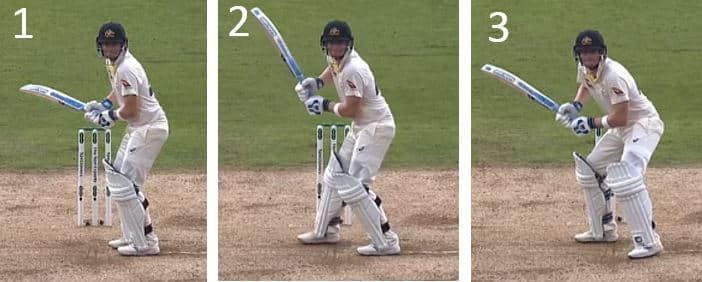
Picture 3 shows Smith’s final position as he is about to receive the ball. Here you can see that his front leg has only shifted a small amount from its original position – moving slightly closer to the middle stump with his foot turning so that his toes point towards cover. You can see that once he is in this position he is very nicely balanced, with his head and eyes level, ready to watch the ball as it leaves the hand.
When the ball is bowled, Smith will quickly move his front leg where it needs to be in order to play an accurate shot. If the ball is full, he will move the front foot a decent distance down the pitch towards the ball. If the ball is short, he will take a small step with his front foot and stand tall in order to play a shot like the hook or the cut.
Side-On View
The side-on view isn’t as interesting for Steve Smith as most of his movement occurs in one direction, from the leg stump to the off stump. During his trigger move his feet don’t really move backwards or forwards, so it’s hard to pick up anything significant from the side-on view! However, the photos below do help to show how Smith leans forward as he is about to receive the ball. By moving his back foot across to the off stump early, the body naturally wants to bring the front foot forwards, and you can see that Smith is about to do this in picture 2 below. As I mentioned previously, this front foot movement will be larger if he receives a full ball, and smaller if he receives a short ball.
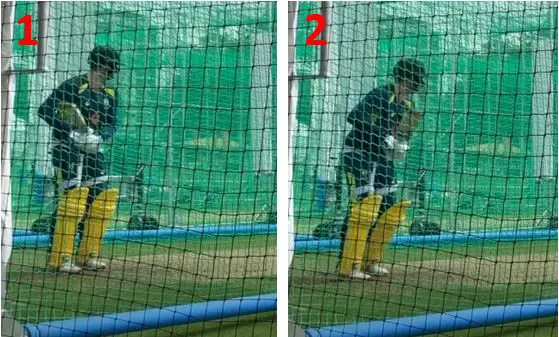
Virat Kohli’s Trigger Movement
Virat Kohli is another one of the world’s best batsmen, and is someone that I always look forward to watching. He is unstoppable in shorter forms of cricket, and excels in test cricket too. He made a few changes to his technique back in 2018 that allowed him to cope with the swinging ball a little better, and he seems to have stuck with that technique ever since! Let’s check it out…
Front-On View
Pictures 1, 2 & 3 below show Kohli’s trigger movement in a step by step process. From studying Kohli’s technique, he seems to take guard most commonly between middle and leg stump. This is often referred to as ‘2 leg’, and you can see his basic batting stance in picture 1 below! You can also see how his front foot is not perfectly in line with his back foot – it’s a little more open.
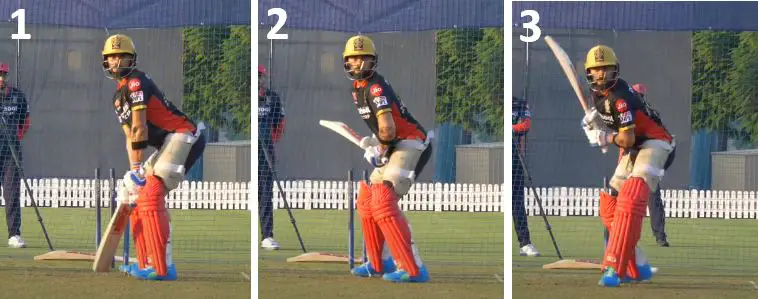
To go from picture 1 to picture 2, Virat shifts his back foot from in between middle and leg stump over towards the off stump. This movement takes place just before the bowler is about to release the ball. Many batsmen like to use their trigger move to get onto the line of off stump as it helps them to judge which balls they can leave and which ones they have to play at.
To go from picture 2 to picture 3, Virat shifts his front leg from its original position onto the line of off stump. This movement occurs just as the ball leaves the bowlers hand. Once Virat picks up where the ball is going, he will quickly adjust the position of his front foot to allow him to play a good shot.
The key here is that Virat never allows his front foot to become completely ‘planted’. Instead, he stands on the ball of the foot, ready to move it quickly to where it needs to be. His final position in picture 3 is a beautifully balanced pose that will allow him to move forwards or backwards swiftly. This is a great position for batsmen to get into at the point of release.
Side-On View
Pictures 1, 2 & 3 below show Virat Kohli’s trigger move from a side-on angle. Although they’re not the best quality pictures, they allow you to get a proper look at Kohli’s movements and how simple they are.
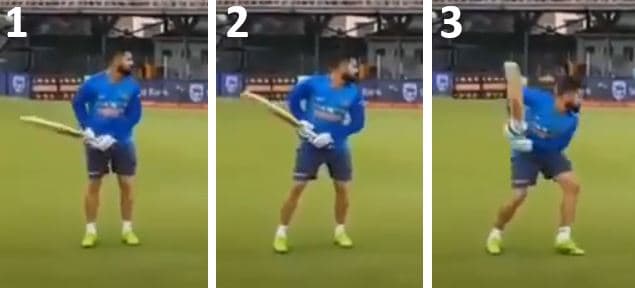
In picture 1, you can see Virat in his basic batting stance, prepared to receive the ball. To get from picture 1 to picture 2, Virat moves his back foot backwards slightly. During this movement, he tries to make sure that his back foot is angled towards the point fielder, instead of allowing it to turn round and point towards the cover region. Virat says that keeping his foot angled towards point helps to stop him getting squared up on the crease.
To move from picture 2 to picture 3, Virat moves his front foot slightly closer to him, bends his front leg and positions his weight over his front knee. When he is in this position, you can see how easily and how quickly he can move forwards or back depending on where the ball pitches. Also, notice how in picture 3 he is on the balls of his feet, ready to react swiftly to the ball.
How To Teach Yourself A New Trigger Movement
As I’ve already mentioned, the goal with a trigger movement should be for it to become second nature to you. Once you’ve become totally comfortable with it, you won’t have to think about it as you’re performing the movement. As a result, you’ll be able to concentrate entirely on the ball and playing the correct shot – which is what all batsmen want to be focusing on!
So how do you get yourself to the point where you don’t have to think about your trigger movement? The answer is simple: practice! You’ll need to practice your trigger for hours in the nets, (preferably against real bowlers) if you want to master it.
If you’re wondering how many hours it will take, I listened to a great interview recently involving Virat Kohli where he talked about how long it took him to become comfortable with changes to his trigger movement. He said that he batted 3 hours a day for around 2 weeks until the movements became completely ingrained in his technique. He also made another good point when he said that if you’re going to perfect anything in sport, you will have to practice it hundreds and hundreds of times!
As we’ve already established earlier in the post, they key to performing your trigger move effectively is the timing of the movements, and the way to properly hone your timing is by performing the movement against real fast bowlers. If you spend hours in the nets doing this, you’ll start to instinctively know when to begin your trigger so that your foot movement perfectly coincides with the delivery of the ball. Some batsmen will face a lot of deliveries from bowling machines in the nets, and this makes it slightly harder to time your trigger movement as you don’t have the opportunity to watch a bowler running in to bowl before you do it.
If you do want to change your trigger movement or add one to your game, I would recommend trying to do so in the off season, rather than during the season. Practice during the winter gives you opportunities to make technical changes without the pressure of having to play a game at the end of the week! By making changes in the off season, you can ensure that you’re fully comfortable with your new trigger movement by the time the season begins!
How Do Trigger Moves Change When Playing Against Spin?
If you’ve been paying attention during this post up until now, you’ll have realised that most of the things that I’ve talked about with regards to trigger movements have been focused on facing fast bowling. As a result, some of you may be wondering if trigger moves change when playing against spin bowling! The answer to this is usually yes!
As we’ve seen, many batsmen will go backwards and across their crease when using a trigger move against fast bowlers, but this often changes when it comes to spin. The vast majority of batsmen will simplify their trigger when batting against spin, and simply look to press forwards on to their front foot instead. Once they have pressed forwards on to their front foot, they can choose to continue their movement forwards if the ball is full, or push back and wait for the ball on the back foot if the ball is short.
Photos 1 – 4 below show illustrate Virat Kohli’s trigger movement when facing spin bowlers. You can see in picture 1 that Virat is in his usual batting stance, with his front foot in the standard, slightly open position. Picture 2 shows Virat’s trigger move against spinners. As you can see, he keeps his back foot in its original position and moves his front foot forwards down the pitch, positioning his weight over his front knee. This isn’t a huge movement, and he is still nicely balanced after he has moved. This front foot movement is commonly referred to as the ‘forward press’.
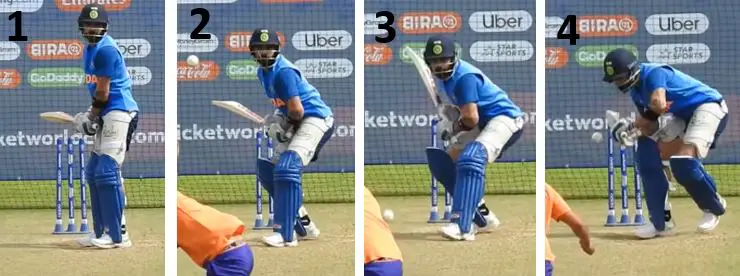
Virat’s position in picture number 2 above means that he is in the perfect position for facing spin bowling. If he sees that the ball is full, he can push his front foot even further forwards and play the ball on the front foot. If he notices that the ball is short, he can quickly push back off his front foot to play the ball deep in his crease. You can see him doing this in pictures 3 & 4! Picture 3 shows the moment that Virat sees that the ball is short, and you can see that he begins pushing his body backwards. Picture 4 shows him deep in his crease, allowing the ball to glance off the face of his bat.
Obviously, some batsmen may use different trigger moves against spin bowlers, but I think the one I’ve just shown you is the one most commonly used by elite batsmen. I’d recommend giving it a try so you can see if it works for you!
Final Words of Advice…
To sum up this post, I’d like to remind you that all of the information I’ve included was intended to guide you, rather than to instruct you. As I mentioned earlier, trigger movements don’t work for everyone, so don’t feel pressured to make any changes to your technique based on what you have read here. However, if you think that something I have mentioned would improve your batting, feel free to start devoting some time to practicing it! Remember, the most effective trigger movements are ones that feel natural to you, so don’t force yourself to do something you’re really not comfortable with!
To close out this post, I’d like to list a few coaching points that you should be aware of when thinking about trigger movements. I may have mentioned most of these already but this will be a good place to summarise them:
- No matter how much you move during your trigger movement, make sure your head and eyes are level when the ball is delivered
- Your trigger move should get you into an athletic position, from which you can react quickly to the ball.
- Try to make sure your legs aren’t too wide apart after your trigger has taken place.
- Ensure that you practice your trigger move enough in the nets before you take it in to real matches
- Don’t make any movements that you’re not comfortable with!
